Heading out the door? Read this article on the new Outside+ app available now on iOS devices for members! Download the app.
Snowshoes are some of the oldest winter gear known to humankind—the tech literally has prehistoric origins, with rudimentary versions having been in use nearly 6,000 years ago. Despite the many evolutions in its humble design, snowshoes still manage to improve every season, with each iteration further boosting flotation, improving grip, and shaving weight. Through the years, our testers have tried hundreds of snowshoes in waist-deep drifts, wet, cement-like snow, and on steep, icy slopes, all in the name of narrowing down the top of the class. Here are the best snowshoes of 2025.
At a Glance
- Best All-Around: MSR Revo Explore ($270)
- Best for Steep Terrain: Atlas Range MTN ($320)
- Most Comfortable: MSR Evo Trail ($170)
- Best for Smaller Feet: MSR Women’s Lighting Ascent Snowshoes ($390)
- Best Binding: TSL Symbioz Hyperflex Instinct ($330)
- Lightest: Crescent Moon Eco Eva Foam ($110)
- Best Bang for Your Buck: Retrospec Drifter Lightweight ($50)
- Best Package Deal: Yukon Charlie Minimalist Kit ($115)
- Best for Deep Snow: Crescent Moon Powder Ski Denali 37 ($207)
- How to Choose Snowshoes
- How We Test
- Meet Our Testers
If you buy through our links, we may earn an affiliate commission. This supports our mission to get more people active and outside. Learn more.

Best All-Around
MSR Revo Explore
$270 at REI (Men’s) $270 at REI (Women’s)
Sizes: 22 in., 25 in.
Weight: Men’s: 3.8 lbs (22 in.), 4.1 lbs (25 in.); Women’s: 3.5 lbs (22 in.), 9.9 lbs (25 in.)
Maximum Load: Men’s: 180 lbs (22 in.), 220 lbs (25 in.); Women’s: 180 lbs (22 in.), 210 (25 in.)
Pros and Cons
⊕ Excellent traction
⊕ Heel lift
⊕ Float tail-compatible
⊗ Pricey
The Revo Explore snowshoes from MSR have been a tester favorite for over a decade: After all, they’re lighter, more flexible, and grippier than most snowshoes on the market today. Credit a hybrid construction, which combines a tough, injection-molded plastic decking with a jagged-edged steel frame and pivoting toe crampon. The most recent iteration includes a brand new binding, which raised the snowshoe’s comfort and security. The binding employs a stretchy rubber mesh that uniformly encompasses feet and prevents pressure points. Our Alaskan testers encountered everything from deep, fresh powder to shoulder-season ice on steep slopes in the Alaska Range, and found the two-way cinch and heel strap never needed to be adjusted while on the go. The ridged, steel frame boosts side traction, while the two front toe crampons and a small, tooth-lined crossbar provided enough bite to push off rolling icy hills and river beds while carrying a 30-pound load in the backcountry of Denali National Park this past winter. Ding? 5-inch tails are $65 extra.
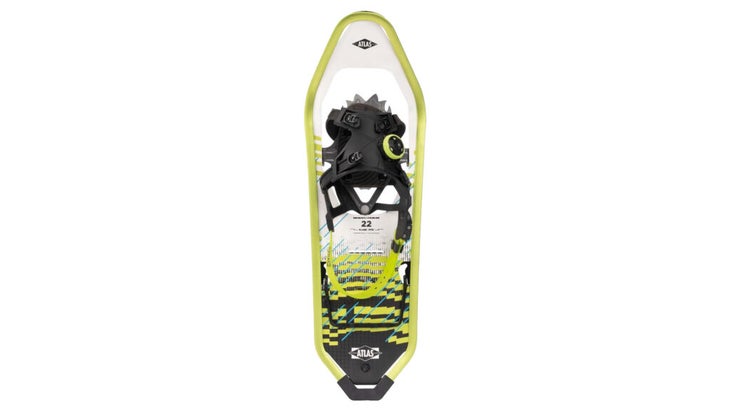
Best for Steep Terrain
Atlas Range MTN
$320 at Backcountry (Men’s) $230 at Amazon (Women’s)
Sizes: Men’s: 26 in., 30 in., 35 in.; Women’s: 22 in., 26 in.
Weight: Men’s: 4.2 lbs (26 in.), 5.1 lbs (30 in.), 5.5 lbs (35 in.); Women’s: 3.6 lbs (22 in.) 3.8 lbs (26 in.)
Maximum Load: Men’s: 180 lbs (26 in.), 235 lbs (30 in.), 300 lbs (35 in.); Women’s: 150 lbs (22 in.), 180 lbs (26 in.)
Pros and Cons
⊕ Easy-to-adjust BOA binding
⊕ Good frame traction
⊕ Multidirectional gripping
⊕ Heel lift
⊗ Expensive
Our Montana-based tester was grateful for the four, long crampon toe points protruding from the Atlas Range-MTN when climbing up dry, crumbly snow with a breakable crust in the Bitterroot National Forest. Those aggressive claws gave him total security without having to kick in steps and made these ‘shoes some of the best for tackling steep terrain. We also loved the simple BOA binding system, which tightened over the front of the foot with one twist of the dial. “I spent hardly any time fiddling with the bindings while hiking, and was able to tighten them even with gloves on,” our tester reported after a 9-mile hike in Montana’s Kootenai National Forest. The standard 19-degree heel lift is perfect for steep hills, while the elongated aluminum frame can handle heavier loads, like a 25 pound pack, in mountainous terrain.
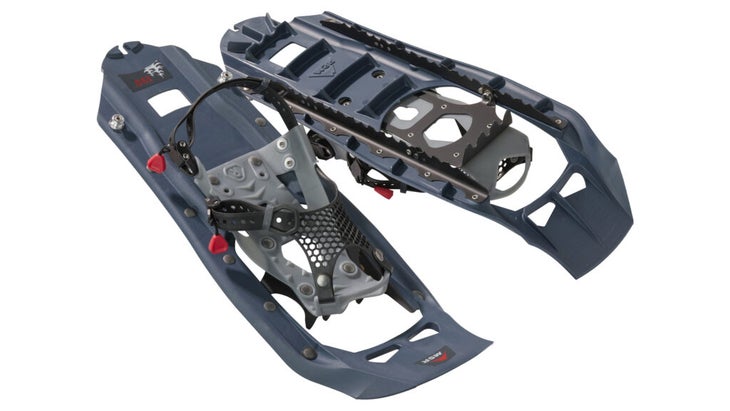
Most Comfortable
MSR Evo Trail Snowshoes
$170 at REI $170 at Backcountry
Size: 22 in.
Weight: 3.6 lbs
Maximum Load: 180 lbs
Pros and Cons
⊕ One size fits all
⊕ Affordable
⊕ Float tail compatible
⊗ No heel lift
The MSR Evo Trail has been a favorite for our Prince Edward Island-based tester for the last 11 years thanks to its simple bindings, durable design, and low price. Her biggest gripe with previous versions was with the finicky toe binding, which would loosen as she walked. The newest iteration solves that problem with new bindings: a one-piece, rubber mesh overlay wraps around the toes and a heel strap tightens or loosens with a simple pull buckle. During 80 miles of testing with the Evo Trails, our tester noted how simple, durable, and stable the new bindings felt compared to the old ones. The boxy frame and injection-molded plastic decking kept her afloat during a storm that dropped 10 inches of fresh powder on PEI. With serrated steel traction rails and a front toe crampon, these snowshoes can handle hilly, icy slopes admirably. And at 22 inches long, they are small enough to strap to your pack when not in use.
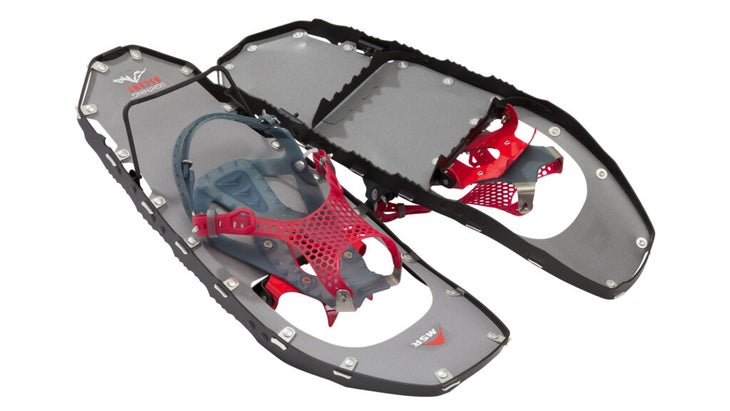
Best for Smaller Feet
MSR Women’s Lightning Ascent
$390 at REI $390 at Backcountry
Sizes: 22 in., 25 in.
Weight: 3.8 lbs (22 in.), 4 lbs (25 in.)
Maximum Load: 180 lbs (22 in.), 210 lbs (25 in.)
Pros and Cons
⊕ Good frame traction
⊕ Easy-to-use binding
⊕ Heel lift
⊗ Expensive
Many snowshoes are unisex, which means they tend to be too big for lighter folks who don’t need the oversized frame. The women’s-specific Lightning Ascents are nearly an inch narrower and five ounces lighter than the men’s version, making them perfect for smaller people with narrow gaits, according to our five-foot, two-inch, 123-pound Quebec-based female tester. The Ascent’s binding, a comfortable rubber mesh toe cup that secures via two rubber side straps that buckle into place, is dead-simple to use with just a quick two handed pull. After testing the Ascent in tricky, technical terrain and on 35-degree slopes at Smugglers Notch, Vermont, she praised the tooth-lined stainless steel frame and pivoting, two-pronged toe crampons, which bit into hardened snow. But the Lightning Ascent isn’t just ideal for smaller snowshoers: Our 5’10”, 155-pound tester also found the precise, narrow ‘shoe design useful while climbing the gullied slopes of northern Vermont.
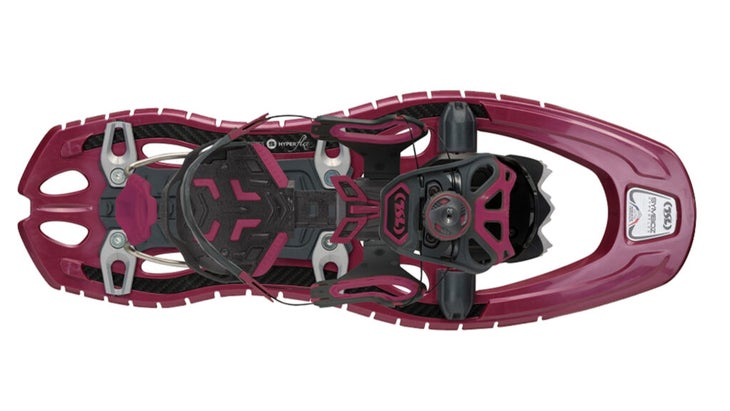
Best Binding
TSL Symbioz Hyperflex Instinct
$330 at Backcountry $340 at Amazon
Sizes: 20.5 in., 23.5 in., 27 in.
Weight: 4 lbs (20.5 in.), 4.3 lbs (23.5 in.), 4.9 lbs (27 in.)
Maximum Load: 180 lbs (20.5 in.), 260 lbs (23.5 in.), 300 lbs (27 in.)
Pros and Cons
⊕ Intuitive BOA system
⊕ Multi-direction crampons
⊕ Flexible
⊕ Heel Lift
⊗ Expensive
⊗ Not tail compatible
⊗ Not great in powder
For those who loath fiddly snowshoe bindings, the Symbioz Hyperflex Instinct is a godsend. While several snowshoes incorporate BOA closures into their design, few are quite as simple as the Instinct’s. Our Oregon-based tester loved the design: a single knob tightens the toe, sides, and heel using interlinked cables that run through the perimeter of the binding. It takes fewer than 10 seconds to step into and secure the snowshoe, but the Instinct stayed glued to our boots all day long, even while walking on slanty, iced-over trails in the Eagle Cap Wilderness. Another characteristic we loved: flexible decking made of injection-molded polypropylene. The pliable material gave us just enough torsional flexibility to enhance comfort and reduce ankle twisting on uneven surfaces. While sidehilling through Oregon’s Eagle Cap Wilderness, eight lateral stainless steel teeth and three-pronged crampons kept our PNW tester upright and stable.
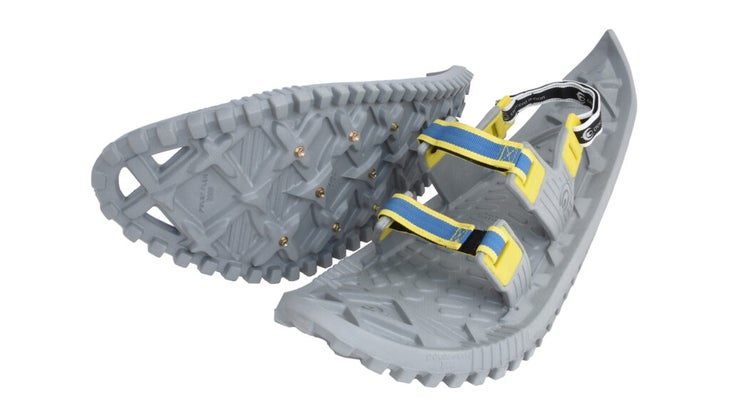
Lightest
Crescent Moon Eco Eva Foam Snowshoes
Sizes: 22 in.
Weight: 2.5 lbs
Maximum Load: 160 lbs
Pros and Cons
⊕ Lightweight
⊕ Relatively sustainable
⊕ Easy to put on
⊗ Middling traction on steeps
⊗ Velcro can become loose
⊗ No heel lift
We were initially skeptical of a snowshoe made of biodegradable foam, but that material choice made this not only the most eco-friendly snowshoe in the test, but the lightest, too. According to Crescent Moon, the EVA is mixed with a mineral compound that eats away at the foam when buried. (We haven’t tried it, and don’t recommend putting it in your compost bin.) Regardless of its environmental claims, our Alaska-based tester reported that the foam gave a much-need bounce to his step while running down packed snow in Denali National Park: The aggressively curved, single-piece EVA platform flexed and rolled with his foot through each stride, making him faster and less fatigued after a full day of ‘shoeing.
Three, simple-to-use Velcro attachments make strapping in easy, although our tester noted that snow build-up underneath could loosen the fit. Ten small metal studs on the bottom offer just enough traction to traverse frozen flats, but not steep icy hills. And, while they’re great for casual use, the Eco Eva Foams are not the best for powder given their narrow girth and shorter, 22-inch size.
Still, it’s hard to beat these bouncy flotation devices in the weight department: Our tester carried the the two-and-a-half-pound snowshoes as a “precaution against late-season snow” during his 9-mile trek of the Triple Lakes Trail and hardly noticed them strapped to his pack.
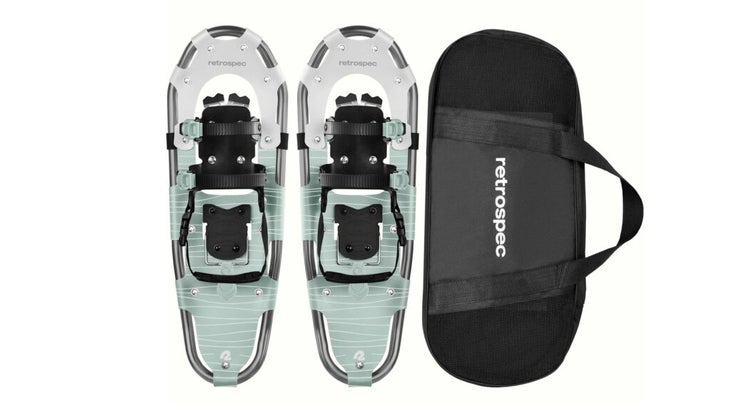
Best Bang for Your Buck
Retrospec Drifter Lightweight
$50-70 at Amazon $50-70 at Retrospec
Sizes: 21 in., 25 in., 30 in.
Weight: 4 lbs (21 in.), 4.2 lbs (25 in.), 4.7 lbs (30 in.)
Maximum Load: 120 lbs (21 in.), 160 lbs (25 in.), 210 lbs (30 in.)
Pros and Cons
⊕ Affordable
⊕ Heel lift
⊕ Ratchet bindings
⊗ No side rail traction
It’s not easy to find a quality pair of snowshoes for under $100, but the Drifter Lightweights more than halves that target by using tried-and-true materials: old-school aluminum alloy and polyethylene. But simple doesn’t mean spare: The Drifter has a heel-lift riser that’s sturdy enough to support weight on undulating terrain while reducing strain on calf muscles. Stainless steel crampons effectively dig into icy slopes thanks to a ring of steel teeth under the ball of the foot and a small, serrated, U-shaped piece of steel under the heel. On multiple trips through Washington’s Okanogan-Wenatchee National Forest in variable conditions, our tester cinched the two individual ratchet straps over the foot tightly with one hand and never needed to readjust. The separate back heel strap also stayed locked in throughout testing adventures. The Retrospec Drifters aren’t perfect, though. They’re noisy to walk in—annoying on dead-silent winter trails—and lack lateral traction.
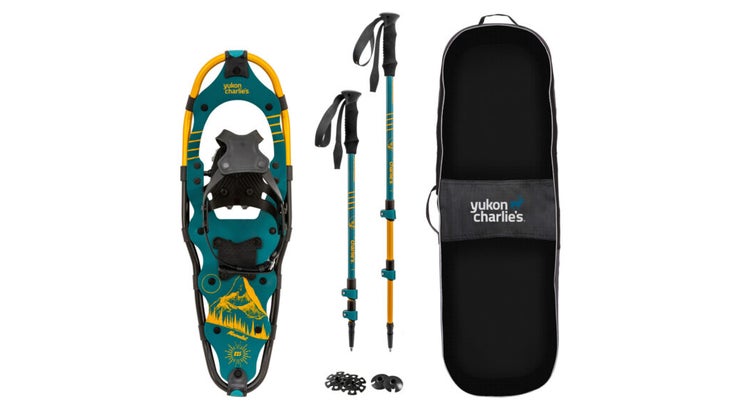
Best Package Deal
Yukon Charlie Minimalist Kit
Sizes: 21 inches, 25 inches, 30 inches
Weight: 3.9 lbs (21 in.), 4 lbs (25 in.), 4.7 lbs (30 in.)
Maximum Load: 150 lbs (21 in.), 200 lbs (25 in.), 250 lbs (30 in.)
Pros and Cons
⊕ One-pull binding system
⊕ Comes with poles, baskets, and storage bag
⊕ Affordable
⊗ No heel lift
For first-time or infrequent winter adventurers, an affordable, all-in-one kit like this one from Yukon Charlie makes a lot of sense: The Minimalist setup comes with snowshoes, a pair of telescoping aluminum poles with snow and hiking baskets, and a storage bag. On their own, the snowshoes are a perfect mid-tier beginner set. The thick plastic heel strap tightens the entire binding with one pull. Said our novice tester of the user-friendly binding: “These are hassle-free, with no need for on-the-go adjustments.” Floatation is solid, thanks to an 8-inch wide aluminum frame and plastic decking, which helped our tester stay afloat in deep snow in Montana’s Bitterroot National Forest. And nearly 60 mini steel crampon teeth surrounding the underside of the foot allowed our tester to dig into icy trails and slick slopes without backsliding or slipping.

Best for Deep Snow
Crescent Moon Powder Ski Denali 37
$208 at Amazon $208 at Crescent Moon
Size: 37 in.
Weight: 5.2 lbs
Maximum Load: 300 lbs
Pros and Cons
⊕ Great in deep powder
⊕ Handles heavy loads
⊗ No heel lift
⊗ Heavy
Nearly the size of a longboard, this monster snowshoe is meant for off-trail routes in deep snow. With a generous load limit of 300 pounds and the ability to fit size-15 shoes, it’s also built for larger folks and heavy loads. All 190 pounds of one Alaskan tester and his pack stayed afloat while navigating 3 feet of fresh powder on the Mountain Vista Trail in Denali National Park: “I would have sunk to my waist without such a large footprint,” he said. With a width of 10 inches and a length of nearly 37 inches—one of the largest snowshoes we’ve ever tested—the Powder Ski plowed ahead through breakable crust and other undesirable snow conditions. (Downside: It’s simply too cumbersome for groomed trails or anything requiring careful footwork.) A slip-in binding with a one-strap pull system and ratcheting heel strap provide equal tension all around. Five sets of stainless-steel crampons around the toe, ball of the foot, and heel tested well in variable shoulder season conditions and icy stretches of terrain. Despite the grip, the Powder Ski Denali 37s are not meant for sidehilling or sketchy slopes given their size—our tester had several near-misses on steeper terrain.
How to Choose Snowshoes
Flat, uncomplicated terrain doesn’t require too much from a pair of snowshoes. Simple, comfortable bindings and a deck that provides adequate flotation are all you need. If icy slopes or deep snow aren’t in your future, save money with a budget pair made from heavier molded plastic and less aggressive traction.
On the other end of the spectrum are snowshoes built for challenging terrain—slushy hills, narrow singletrack, or mixed rock and ice. A secure wrap around the heel and/or multiple straps along the foot are important for stability. Quick binding systems, like those that utilize a BOA twist lock, are helpful when taking snowshoes on and off in precarious terrain and a huge time-saver compared with fiddly three-strap setups. Snowshoes geared towards mountainous ascents will have a wider variety of spikes and crampons underfoot—and in more abundance—to offer grip both horizontally and laterally, and to bite through different types of ice. A heel lift that provides about 2 inches of lift (that’s easy to flick open and closed with either gloved hands or a trekking pole) is a must for giving your feet and calves an assist on the steeps.
In deep, fresh powder, you’ll want wider, longer snowshoes (or those that come with extensions) for superior flotation. On the flipside, if you’re headed out on a weight-conscious backpacking trip and/or plan to strap the snowshoes to your pack for much of the trip, prioritize lightweight construction, like a pair made from aluminum and TPU-coated nylon, for reducing fatigue on-foot and outside your pack.

How We Test
- Number of testers: 11
- Number of products tested: 20
- Miles logged while testing: 220
- Places we tested: Alaska, Washington, Montana, Oregon, California, Colorado, Vermont, Prince Edward Island, Quebec
- Coldest temperature: -42 degrees (Healy, Alaska)
- Highest Elevation reached: 9,300 ft
Over the past several years, 25 veteran testers from all over the world ventured out into some of the coldest and snowiest conditions with dozens of pairs of snowshoes. Only nine models stood up to the rigors of our testing to earn a spot on this list.
We looked at design, features, ease of use, comfort, traction, cost, weight, and floatation in deep snow to narrow down the best of the best from the current market. This year, some tried-and-tested snowshoe models received updates, like new bindings and decking materials, which we then reevaluated. Others haven’t changed through the years: their simple designs and technologies have withstood the test of time.
Meet Our Testers
Justin La Vigne
Category manager Justin La Vigne lives just outside Denali National Park and Preserve in Alaska. When not writing, he is a professional backcountry guide, taking people hiking and backpacking all over Alaska, and has personally logged 7,000+ trail miles. He has too many snowshoes stationed at his front door, but uses them daily for getting around his property and exploring the frozen landscape of Alaska. He has a core group of about 25 testers from all over the world to help him vet out the best of the best in the field.
Mark Wetherington
Veteran tester Mark Wetherington, resides in Hamilton, Montana, just a few miles away from the Selway-Bitterroot Wilderness. Even though he does most of his snowshoe testing there, he is always seeking out “the next best place to wake up”—whether it’s an alpine lake, hot spring, or an old fire lookout. Mark is currently director of the Bitterroot Public Library. He is the co-author of “Backpacking Washington, 3rd Edition” published by Wilderness Press in 2020. His writing has also appeared in Backpacker Magazine, Backpacking Light, and Trails Magazine. He has been testing gear since 2017.